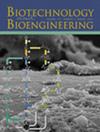大肠杆菌外膜囊泡促进小分子抗生素的非孔蛋白摄取。
IF 3.6
2区 生物学
Q2 BIOTECHNOLOGY & APPLIED MICROBIOLOGY
引用次数: 0
摘要
对革兰氏阴性菌有效的新型抗菌药物的开发受到革兰氏阴性菌双膜细胞包膜的阻碍。为了达到细胞内的目标,大多数小分子抗生素必须首先通过称为孔蛋白的蛋白质通道;然而,获得性耐药的一个共同机制是这些外膜蛋白的表达减少。此外,大小、形状和电荷等参数调节着抗生素通过孔蛋白的通道,进一步限制了新型抗生素分子的设计空间。受细菌外膜囊泡(omv)向细菌胞质输送货物能力的启发,我们假设将小分子抗生素包封在omv内可以通过促进药物的吸收来提高药物的活性。为了验证这一假设,我们研究了亚胺培南封装的omv抑制几种革兰氏阴性菌生长的能力,包括耐多药(MDR)临床分离株。我们的研究结果表明,omv内的包封显著降低了几种耐多药菌株亚胺培南的有效浓度。使用一组孔蛋白敲除菌株,我们进一步证明了这种抗生素递送机制不需要孔蛋白表达。总之,我们的研究结果证明了omv作为新型抗生素递送载体的潜力,可以通过改善药物摄取来治疗抗生素耐药细菌感染。本文章由计算机程序翻译,如有差异,请以英文原文为准。
Porin-Independent Uptake of Small Molecule Antibiotics Facilitated by Escherichia coli Outer Membrane Vesicles.
The development of novel antimicrobial agents that are effective against Gram-negative bacteria is hindered by the dual membrane cell envelope of these bacteria. To reach their intracellular targets, most small-molecule antibiotics must first pass through protein channels called porins; however, a common mechanism of acquired resistance is decreased expression of these outer membrane proteins. Additionally, parameters such as size, shape, and charge regulate passage of antibiotics through porins, further limiting the design space of novel antibiotic molecules. Inspired by the ability of bacterial outer membrane vesicles (OMVs) to deliver cargo to the bacterial cytosol, we hypothesized that encapsulation of small molecule antibiotics within OMVs would improve the activity of the drugs by facilitating uptake. To test this hypothesis, we investigated the ability of imipenem-encapsulated OMVs to inhibit the growth of several Gram-negative bacteria, including multidrug-resistant (MDR) clinical isolates. Our results demonstrated that encapsulation within OMVs significantly lowers the effective concentration of imipenem in several MDR isolates. Using a panel of porin knockout strains, we further demonstrated that this mechanism of antibiotic delivery does not require porin expression. Together, our results demonstrate the potential of OMVs as novel antibiotic delivery vehicles to treat antibiotic-resistant bacterial infections by improving drug uptake.
求助全文
通过发布文献求助,成功后即可免费获取论文全文。
去求助
来源期刊

Biotechnology and Bioengineering
工程技术-生物工程与应用微生物
CiteScore
7.90
自引率
5.30%
发文量
280
审稿时长
2.1 months
期刊介绍:
Biotechnology & Bioengineering publishes Perspectives, Articles, Reviews, Mini-Reviews, and Communications to the Editor that embrace all aspects of biotechnology. These include:
-Enzyme systems and their applications, including enzyme reactors, purification, and applied aspects of protein engineering
-Animal-cell biotechnology, including media development
-Applied aspects of cellular physiology, metabolism, and energetics
-Biocatalysis and applied enzymology, including enzyme reactors, protein engineering, and nanobiotechnology
-Biothermodynamics
-Biofuels, including biomass and renewable resource engineering
-Biomaterials, including delivery systems and materials for tissue engineering
-Bioprocess engineering, including kinetics and modeling of biological systems, transport phenomena in bioreactors, bioreactor design, monitoring, and control
-Biosensors and instrumentation
-Computational and systems biology, including bioinformatics and genomic/proteomic studies
-Environmental biotechnology, including biofilms, algal systems, and bioremediation
-Metabolic and cellular engineering
-Plant-cell biotechnology
-Spectroscopic and other analytical techniques for biotechnological applications
-Synthetic biology
-Tissue engineering, stem-cell bioengineering, regenerative medicine, gene therapy and delivery systems
The editors will consider papers for publication based on novelty, their immediate or future impact on biotechnological processes, and their contribution to the advancement of biochemical engineering science. Submission of papers dealing with routine aspects of bioprocessing, description of established equipment, and routine applications of established methodologies (e.g., control strategies, modeling, experimental methods) is discouraged. Theoretical papers will be judged based on the novelty of the approach and their potential impact, or on their novel capability to predict and elucidate experimental observations.
 求助内容:
求助内容: 应助结果提醒方式:
应助结果提醒方式:


